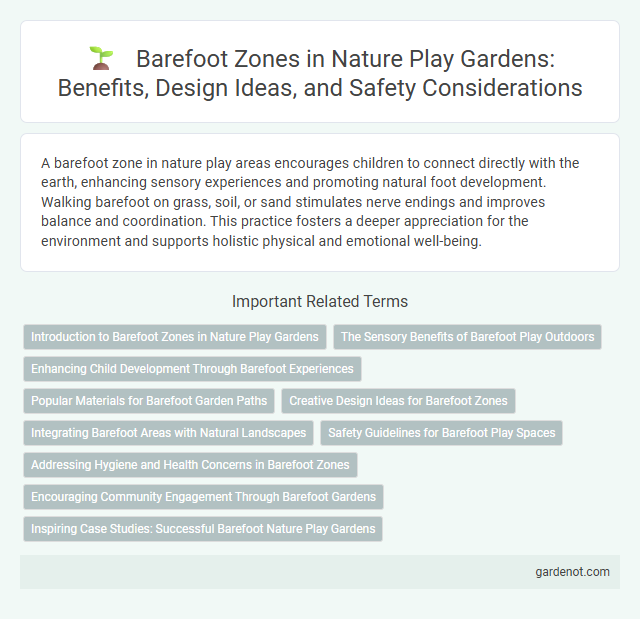A barefoot zone in nature play areas encourages children to connect directly with the earth, enhancing sensory experiences and promoting natural foot development. Walking barefoot on grass, soil, or sand stimulates nerve endings and improves balance and coordination. This practice fosters a deeper appreciation for the environment and supports holistic physical and emotional well-being.
Introduction to Barefoot Zones in Nature Play Gardens
Barefoot zones in nature play gardens create sensory-rich environments that stimulate children's tactile experiences by encouraging them to walk barefoot on diverse natural textures such as grass, sand, pebbles, and soft soil. These zones enhance physical development, balance, and grounding while fostering a deeper connection to nature through direct skin contact with organic materials. Incorporating barefoot zones supports sensory integration and promotes mindfulness during outdoor play, making them essential components of innovative nature-based learning spaces.
The Sensory Benefits of Barefoot Play Outdoors
Barefoot play in outdoor barefoot zones enhances sensory development by stimulating nerve endings in the feet, improving balance, coordination, and spatial awareness. Natural textures like grass, sand, and soil provide varied tactile experiences that promote neural connections and sensory integration in children. Exposure to diverse surfaces also supports proprioception, aiding body awareness and motor skills essential for healthy physical growth.
Enhancing Child Development Through Barefoot Experiences
Barefoot zones in nature play areas stimulate sensory development by engaging children's tactile senses with varied natural textures such as grass, sand, and soil. Walking barefoot enhances balance, coordination, and proprioception, critical for motor skill advancement and physical health. Exposure to natural elements in barefoot zones also supports immune system strength and encourages mindfulness by fostering a deeper connection with the environment.
Popular Materials for Barefoot Garden Paths
Popular materials for barefoot garden paths include natural elements like smooth river stones, soft mulch, and fine gravel, all chosen for their tactile comfort and sensory stimulation. Wood chips and sand provide a gentle texture that encourages foot massage and promotes connection to nature. These materials enhance the barefoot experience by offering varied surfaces that improve balance and foot strength.
Creative Design Ideas for Barefoot Zones
Incorporating natural materials such as smooth river stones, soft moss, and textured wood chips enhances sensory stimulation within barefoot zones, encouraging tactile exploration and imaginative play. Designing varied surface patterns and interactive elements like stepping logs or balance beams fosters physical engagement and creativity in children. Integrating native plants and natural shade not only complements the barefoot experience but also supports biodiversity and environmental education.
Integrating Barefoot Areas with Natural Landscapes
Integrating barefoot areas with natural landscapes enhances sensory experiences by connecting feet directly with earth, grass, sand, and water textures. These barefoot zones promote physical development and mindfulness, encouraging children to explore diverse terrains safely. Designing barefoot trails using native materials supports ecological balance while fostering a deep bond with nature.
Safety Guidelines for Barefoot Play Spaces
Safety guidelines for barefoot play spaces emphasize maintaining clean, debris-free surfaces to prevent injuries from sharp objects and harmful materials. Regular inspections and use of natural, non-toxic materials like soft mulch or sand enhance protection while preserving sensory benefits. Proper drainage and shade structures reduce risk of slips and heat-related issues, ensuring a secure environment for barefoot exploration.
Addressing Hygiene and Health Concerns in Barefoot Zones
A barefoot zone promotes natural sensory experiences while prioritizing hygiene through regular cleaning protocols and the use of non-toxic, pathogen-resistant ground materials like sand, mulch, or grass. Strategic placement away from waste sources and routine surface inspections minimize health risks such as infections and allergies. Incorporating educational signage encourages proper handwashing and safe barefoot practices to maintain a healthy environment for all users.
Encouraging Community Engagement Through Barefoot Gardens
Barefoot gardens transform community spaces into interactive barefoot zones that stimulate sensory exploration and promote environmental awareness. These natural play areas engage participants of all ages by connecting them directly with diverse textures like soil, grass, and pebbles, fostering a deeper appreciation for nature. Vibrant barefoot zones serve as focal points for community gatherings, workshops, and educational activities, strengthening social bonds and encouraging stewardship of local green spaces.
Inspiring Case Studies: Successful Barefoot Nature Play Gardens
Successful barefoot nature play gardens, such as the Forest School in Sweden and the Barefoot Trail at the Columbus Children's Museum, exemplify the benefits of sensory-rich environments that encourage tactile exploration and natural movement. These inspiring case studies demonstrate how integrating diverse natural textures like sand, woodchips, moss, and pebbles promotes physical development and reconnects children with nature. Research from these projects highlights improvements in balance, coordination, and emotional well-being, making barefoot zones essential components of modern nature play spaces.
Barefoot zone Infographic

 gardenot.com
gardenot.com